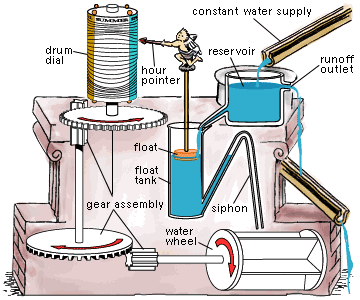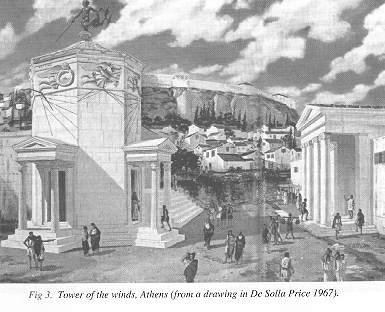Water Clock Experiment Wrap-up
Water Clock Experiment Wrap-up ajlill Wed, 12/10/2008 - 21:26 This is the basic clepsydra (literally "water thief"). This device can be traced back to nearly 2000 BCE in ancient Egypt. This type of clepsydra was often used to time speakers during debates and trials.
This is the basic clepsydra (literally "water thief"). This device can be traced back to nearly 2000 BCE in ancient Egypt. This type of clepsydra was often used to time speakers during debates and trials.
Ctesibius, a Greek inventor and mathematician in Alexandria, Ptolemaic Egypt developed many improvements on the water clock. His clepsydra kept more accurate time than any clock invented until the Dutch physicist Christiaan Huygens detailed the use of a pendulum to regulate a clock in the 17th century.
 One of the problems faced by Ctesibius was the one we investigated in our experiment. That is, as the water level in the upper container, (reservoir) goes down, the flow of water slowed down. This problem was solved by having water flow into the reservoir faster thannit was used by the clock, and have an outflow tube to take the extra water away.
One of the problems faced by Ctesibius was the one we investigated in our experiment. That is, as the water level in the upper container, (reservoir) goes down, the flow of water slowed down. This problem was solved by having water flow into the reservoir faster thannit was used by the clock, and have an outflow tube to take the extra water away.
Another problem facing clock builders is how the Ancient Greeks counted time. Unlike us, the Greeks divided the time between sunrise and sunset into 12 daytime hours, and the time between sunset and sunrise into 12 nighttime hours. As we are sadly aware, the time between sunrise and sunset is much shorter during the winter than the summer. Ctesibius solved this problem by marking the hours with curved lines on a drum. He then added a mechanism that reset the hour pointer every day and turned the drum so the lines matched the season.
 This is a picture of what the Tower of the Winds in the agora would have looked like. It was 12 m tall and about 8 m in diameter. It was supposedly built by Andronicus of Cyrrhus around 50 BC, but according to other sources might have been constructed in the 2nd century BC before the rest of the forum. It was topped in antiquity by a weathervane-like Triton that indicated the wind direction.
This is a picture of what the Tower of the Winds in the agora would have looked like. It was 12 m tall and about 8 m in diameter. It was supposedly built by Andronicus of Cyrrhus around 50 BC, but according to other sources might have been constructed in the 2nd century BC before the rest of the forum. It was topped in antiquity by a weathervane-like Triton that indicated the wind direction.
Triton was the son of Poseidon and the Amphitrite, goddess of the sea. He was the messenger of the deep and carried a conch shell with which he could raise or quiet the waves.
Around the top is a frieze depicting the eight wind deities — Boreas (N), Kaikias (NE), Eurus (E), Apeliotes (SE), Notus (S), Livas (SW), Zephyrus (W), and Skiron (NW). Below them were eight sundials. You can see the lines marking the hours below the frieze. Inside, there was a clepsydra, driven by water coming down from the Acropolis.